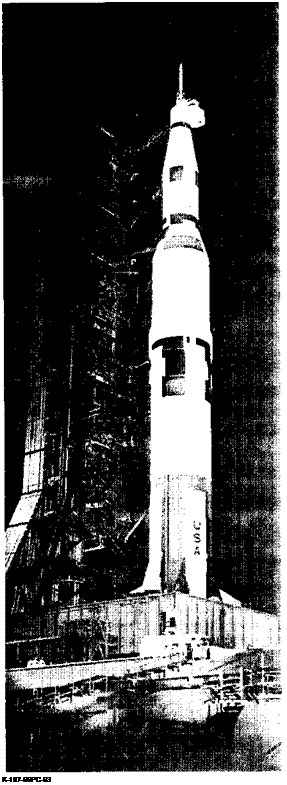MOBILE LAUNCHER
The mobile launcher is a movable launch platform with an integral umbilical tower. The launcher base
|
K-107-66PC-91 |
Arrival to Launch Pad—The facilities vehicle arrives at Launch Complex 39A.
![]()
is a two-story steel structure covering more than half an acre. The 380-foot tower, which supports the electrical servicing and fluid lines for the vehicle, is a steel structure mounted on the base. The base and tower weigh 10.5 million pounds and stand 445 feet above ground level.
Among major considerations in design of the mobile launcher were crew safety and escape provisions
and protection of the platform and its equipment from blast and sonic damage.
Personnel may be evacuated from upper work levels of the umbilical tower by a high speed elevator, descending at 600 feet per minute. After leaving the elevator, they can drop through a flexible metal chute into a blast and heatproof room inside the base of the pad hardstand.
The mobile launcher provides physical support and is a major facility for checkout of the space vehicle from assembly at the VAB until liftoff at the launch
site.
The top level of the launcher base houses digital acquisition units, computer systems, controls for actuation of service arms, communications equipment, water deluge panels, and other control units. Included in the lower level are hydraulic charging units, environmental control systems, electrical measuring equipment, and a terminal room for instrumentation and communications interface. Mounted on the top deck of the base are four vehicle holddown and support arms and three tail service masts.
The umbilical tower is an open steel structure providing support for nine umbilical service arms, 18 work and access platforms, and, for propellant, pneumatic, electrical, water, communications, and other service lines required to sustain the vehicle. A 250-ton capacity hammerhead crane is mounted atop the umbilical tower.
The launcher restrains the vehicle for approximately 5 seconds after ignition to allow thrust buildup and verification of full thrust from all engines. The design “up-load” during the holddown period is 3 million pounds. If one or more of the engines fail to develop full thrust, the vehicle is not released, and all engines automatically are shut down.

Night Shot—A 365-foot-tall Saturn V facilities vehicle Is shown in place at Launch Pad 39A.
SATURN V NEWS REFERENCE











